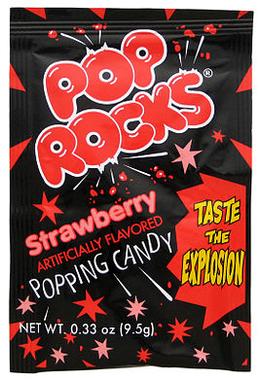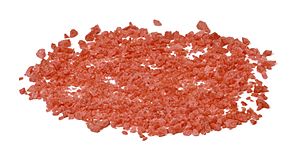Pop Rocks facts for kids
Pop Rocks is a super fun candy that makes tiny popping sounds in your mouth! It's owned by a company called Zeta Espacial S.A. The main things in Pop Rocks are sugar, lactose (which is a type of sugar found in milk), and different flavorings.
What makes Pop Rocks special is how they're made. Unlike regular hard candies, Pop Rocks have tiny bubbles of pressurized carbon dioxide gas trapped inside them. When the candy melts in your mouth, these gas bubbles are released, making that cool popping and fizzing feeling!
The Story of Pop Rocks
The idea for Pop Rocks was first thought up by two chemists, Leon T. Kremzner and William A. Mitchell, who worked for a company called General Foods. They got a patent for their idea way back in 1961.
But the candy wasn't sold to people until 1975. General Foods stopped making Pop Rocks in 1983 because it wasn't selling as well as they hoped, and it didn't stay fresh for very long.
At first, the company tried to control where the candy was sold to keep it fresh. But Pop Rocks became so popular that people started moving it from one market to another without permission. This meant some candy reached customers when it wasn't fresh anymore.
Later, another company called Kraft Foods gave Zeta Espacial S.A. permission to make Pop Rocks. Eventually, Zeta Espacial S.A. became the full owner and only maker of the candy. Today, Pop Rocks are sold in the U.S. by Pop Rocks Inc. In other parts of the world, Zeta Espacial S.A. sells them. They also sell similar popping candies under names like Peta Zetas and Wiz Fizz.
In 2008, a scientist named Dr. Marvin J. Rudolph wrote a book about how Pop Rocks were developed. The book is called Pop Rocks: The Inside Story of America's Revolutionary Candy. It shares stories from people who helped create the candy.
There was also a similar candy called Cosmic Candy, which used to be called Space Dust. It was a powdered version of popping candy and was also made by General Foods.
In 2012, a company in Australia called Cadbury Schweppes started making a chocolate bar with popping candy inside. It was called "Marvellous Creations Jelly Popping Candy Beanies." A New Zealand company, Whittakers, also made a white chocolate bar with a local fizzy drink flavor and popping candy. Even famous British chef Heston Blumenthal has used popping candy in his desserts! He likes it for the unique feeling it gives and because it reminds people of the 1970s.
How Pop Rocks Are Made
Making Pop Rocks is quite interesting! First, sugars are dissolved in water. This sugary water is then heated to a very high temperature, about 320 °F (160 °C), until most of the water has evaporated.
Next, the hot sugar mixture is cooled a bit to about 280 °F (138 °C). While it's being stirred very fast, it's put under a lot of pressure with carbon dioxide gas. Think of it like a super-fizzy soda, but with candy!
The mixture is then kept under this high pressure and allowed to cool down and become solid. This process traps all those tiny carbon dioxide gas bubbles inside the candy. Most of these bubbles are super small, much smaller than a human hair!
When the pressure is released from the solid candy, it breaks into many small pieces. Each piece has those trapped gas bubbles, ready to pop when you eat them!
See also
 In Spanish: Peta Zetas para niños
In Spanish: Peta Zetas para niños



